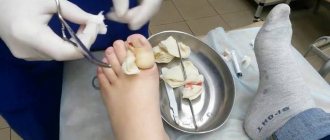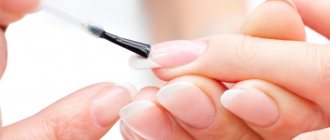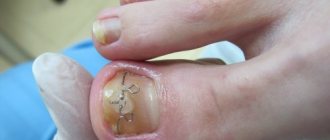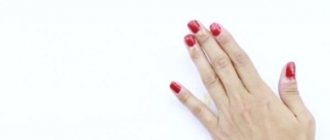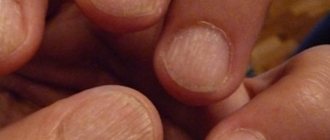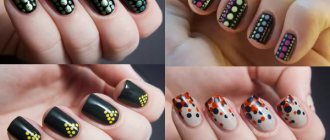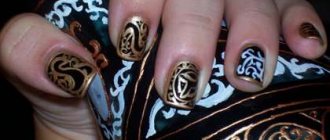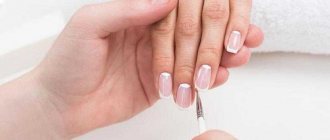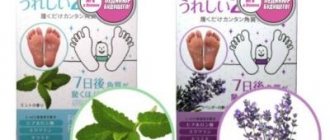Nail structure
The nail plate is the visible part of the nail, from the growth zone to the free edge.
The growth zone, or matrix , is located under the skin. It produces cells called onychoblasts. They are born by division, mature, go through their life cycle, which takes 3 weeks, and then emerge keratinized to the surface. They no longer contain water, cytoplasm and nucleus, as in living cells. That is why nails do not need nutrition, only the cuticle area needs it.
They also do not breathe, this is a very common misconception. You can wear the coating without interruption, it does not affect the plate in any way. On the contrary, the coating additionally strengthens the thin plates and protects them from external chemical and physical factors.
Dead cells become scales and are stacked in layers, layers, forming plates. Between the layers of keratinized cells there are small layers of fat and water, which give the nails elasticity and shine.
The socket is the part of the nail root that extends to the surface. This is what we see as a white semicircle at the base.
The nail plate is located on the skin of the phalanges of the fingers. This area is called the nail bed. Vessels pass through it, which give the plate a pink tint. It itself has a white translucent color, like the cells that form it.
How is the nail plate attached to the bed? Both surfaces have systems of grooves that interact with each other and provide strong adhesion. If these connections are broken, the nails peel off. This disease is called onycholysis. Simple cases can be corrected by a salon technician, but in case of pathologies you need to go to a medical facility.
The nail ends with a free edge. This is a section of the plate that is no longer adjacent to the skin. It is also called the butt. During a manicure, the free edge of natural nails is cut down or shaped, strengthened with biogels or dense bases, and for artificial plates modeling is done with gel, acrylic or acrylic.
The sides of the nail are framed by side ridges. They are mobile and prone to keratinization, especially on aging hands. They are also treated during a manicure. The lateral sinuses are grooves that separate the lateral rollers from the plates.
The cuticle is a protective skin located in the growth zone or matrix (see photo). What is it for? In this vulnerable area, it protects the nail from mechanical and chemical influences.
The pterygium is the keratinized part of the cuticle. It is clearly visible to the naked eye and has the shape of whitish plates or “films” located under the cuticle and lateral sinuses of the ridges (see photo).
Pterygium that is not completely removed during manicure is most often the cause of detachments of gel polish and extended plates.
Components of the nail
The substrate is the extension following the matrix that supports the nail plate on the legs and arms and determines its color and health. The substrate is connected to the plate by small cells.
The hole is the outline of a crescent, whose pronounced pattern is inherent in the thumb, but the little finger practically does not have it.
We recommend reading:
Cuticle removal - tips on choosing products and an overview of the best removal methods. 130 photos and videos of cuticle careHow to restore nails after gel polish - a review of the best means and methods of restoration at home (120 photos + video master class)
Magnet for a cat's eye: tips on how to apply iridescence simply and beautifully with your own hands (110 photos + video)
The skin border around it is the cuticle, which acts as protection.
A young rim tends to grow into the nail, which leads to ruptures, resulting in the formation of hangnails that spoil the external image. They also open the “gate” for microbes.
What healthy nails and skin should look like
In a healthy state, the nail has a light pink or pink color, a uniform, smooth surface, without grooves or notches. Healthy skin around the plates is pink, elastic, and may be slightly dry due to frequent contact with water, which can be easily eliminated by constant use of moisturizer.
Chemical composition of nails : 60% protein keratin. 15% - water, 5% - sulfur, which provides strength, 5% - other minerals: selenium, zinc, calcium, chromium, phosphorus. 15% are fats, which together with water hold the layers of keratin together.
The growth rate of nails is 4-5 mm per month. In women they grow faster than in men, by about 20%. You can also track seasonal changes: in summer and spring they grow faster than in winter and autumn.
You need to take care of the skin of your hands and nails, and monitor the possible appearance of symptoms of diseases or simply weakening of the health of your nails.
Nail composition
The nail surface is mainly composed of hundreds of layers of keratin fibers and keratinized protein (more than fifty percent of the composition), which interact together to provide strength to the nail bed.
The composition also includes other components:
- Water - about twenty percent. Because of this, drying out of the nail surface in winter (due to weather conditions) or in summer (under the influence of ultraviolet radiation) leads to the formation of unevenness and roughness on the coating;
- Lipids – fifteen percent. They help to bind keratin fibers together, which prevents brittleness of the nail surface and the formation of detachments on it;
- Sulfur - five percent. It prevents the splitting of layers that contribute to the formation of detachments;
- Microelements: calcium, potassium, magnesium, iron, phosphorus, etc. Maintain a healthy manicure for girls.
A lack of vitamins or nutrients in the composition leads to the formation of problems and diseases of the nail plate. Typically they appear on its appearance:
- Detachments appear.
- Premature breakage of the free edge.
- Ingrown nail.
- The appearance of white spots.
- Yellowness.
- Uneven free edge.
- The appearance of roughness, irregularities, and depressions.
If problems with the nail are detected, it is necessary to treat it, which includes external manipulations with it (caring baths, masks, use of oils) and internal restoration. Internal care involves the use of vitamins and microelements that restore blood circulation in the fingertips and stimulate the regeneration of new epithelial cells.
How to speed up nail growth using home methods
By speeding up the process of cell division in the matrix, you can speed up the growth of the plates. You shouldn't expect magic, but good results can be obtained from the following procedures:
- Daily massage of the fingertips and matrix with soft circular movements or with the index and middle finger of the other hand closed in a lock.
Hand massage: types, technique, recommendations for the procedure - Taking vitamins and minerals for growth will speed up the process a little and make the plates less brittle.
As a result, there will be a faster growth effect, so the ends will not flake and break off. Vitamins for nails - Application of special varnishes and serums to accelerate growth.
Particular attention should be paid to the matrix zone, since this is where cell division occurs. How to use IBX System, all features of the product line - Protect the tips during any household work and physical activity so that they do not simply grind off on hard objects.
- Oil and water based baths with the addition of any components that improve blood circulation in the growth area.
For example, citrus oils, rosemary and tea tree. Hand baths: 30 recipes for different purposes - Capsules with an oily solution of vitamins A and E. You can directly rub the composition into the matrix area 2 times a week for 5-7 weeks under plastic gloves for 30 minutes.
Nail plate.
The nail plate (nail), in turn, consists of many transparent keratinized plates, folded like tiles. Thanks to this structure, the nail plates have a porous structure. They actively absorb and release (sweat) moisture, 100 times more intense than human skin. Exudation through the nails accounts for 12-15% of the exudation of the entire surface of the body. The high permeability of the nail plates allows the effective use of medicinal varnishes and creams to affect the tissues under the nail. Due to this permeability, in people whose hands are often in contact with water, the nail plates become noticeably thicker over time.
Common nail and cuticle problems
A manicurist often encounters the following problems: inflamed or itchy cuticles, hangnails, greening, yellowing of nails. The same problems can be encountered when doing manicures at home.
If the cuticle burns and itches, this is the first sign of an allergy. It can be caused by food or appear after manicure and coating. Top, gel polish, base, primer - all components can cause itching. If such symptoms appear, you must take an antihistamine such as Suprastin, Cetrin or Claritin, and then contact your specialist and remove the coating. Then, by elimination, you can select other components of the coating or replace it with a hypoallergenic complex of base, gel polish and top.
Health hazards of gel polish and its components
Inflamed cuticles or lateral ridges on the arms or legs. If the skin around the plate is red, swollen, or inflamed after a manicure or physical household work, it is necessary to treat the area with zinc or silver ointment. You can also replace them with Spasatel balm or Sudocrem.
Why does the cuticle become inflamed? The reason is the entry of pathogenic bacteria into wounds and microcracks in the skin. It is better to treat the inflamed areas if you plan to have a manicure done in a salon, otherwise it will be difficult for the master to treat the reddened and painful area. If you constantly injure the inflamed cuticle, the area may fester, and then more serious treatment will be required.
Immediately after an injury, if the skin bleeds, it is necessary to treat it with hydrogen peroxide or a disinfectant until the bleeding stops, and then apply one of the above healing agents to avoid inflammation.
If the cuticle turns yellow, this may be due to frequent contact with chemicals that color it in the corresponding color, or it may indicate problems with the liver.
In the first case, you can make lotions from lemon slices, put pieces of cotton pads soaked in micellar water for 7 minutes, or apply toothpaste mixed with soda for 5 minutes and rinse. In the second case, you need to see a doctor for a comprehensive examination and treatment.
If the nails turn green, this indicates the appearance of a fungus or the proliferation of Pseudomonas aeruginosa. At the first signs, it is necessary to remove the artificial turf, treat the problem, heal the diseased areas with deep penetration of fungus or bacteria, and only then return to the decorative decoration.
Nail structure and diseases
A healthy nail is strong, elastic, smooth, translucent, and has a pleasant color. Fragility, yellowness, dullness, furrows and irregularities indicate a particular disease. Brittle nails are caused by:
- lack of nutrition (deficiency of proteins and vitamins)
- the destructive effects of water, household chemicals, and other external factors
- prolonged exposure to the sun
- typing, playing musical instruments
- habit of peeling off varnish
- onychomycosis (fungal nail disease)
Brittle nails.
The nail plate becomes dull and yellow due to:
- smoking
- cardiovascular, endocrine diseases
- taking certain medications
- elderly
- fungus
Irregularities and grooves on the nail plate appear if:
- the root of the nail is injured
- unbalanced human nutrition
- a person has iron deficiency anemia
Furrows on the nails.
Layering of nails is explained:
- using household chemicals without gloves
- lack of vitamins
- habit of biting your nails or picking off polish
- allergies
- internal diseases
- nail fungus
Peeling nails.
About nail fungus and methods of treating it is written here: link
Toenail fungus.
How to remove cuticle and pterygium
The photo illustrates the condition of the cuticle before and after removal by a master using a device. Using cutter attachments, the cuticle is first lifted, the pterygium is removed, and then it is cut off. Most often this is done with a ball attachment. Overgrown, neglected skin requires removal with scissors even with a dry hardware manicure. Read more about the purpose of cutter attachments for hardware manicure.
With a classic trimmed manicure, the cuticle is soaked simply with water or using keratolytics. These are acidic or alkaline compounds that soften the rough skin of the cuticle and side ridges in a matter of minutes, and it is easy to either remove it with an orange stick or cut it with scissors.
Keratolytics for manicure: types, methods of application, brands
How to remove cuticles without cutting? At home, you can remove the cuticle without cutting it using the same keratolytics or removers. The product is applied to the skin around the nail, hands are immersed in water for 2-3 minutes, and then the overgrown skin is removed with an orange stick or pusher, which by then turns into a soft paste. This is convenient for keeping hands well-groomed and with slow cuticle growth. If you have rough and rapidly growing skin, you will still have to use scissors or a device.
Can a person live without nails?
It happens that a person has to live without nails. The reason for this may be:
- Heredity. Congenital complete or partial absence of nails is passed on from generation to generation. Arthro-osteo-onychodysplasia is considered a complex congenital pathology, in which a person lacks not only nails, but also patellas, the pelvic bones and radius bones are formed incorrectly
- Nails come off partially or completely due to disease. Such ailments are psoriasis, lichen, epidermiolysis bullosa, and others.
- Injuries to the nail plate, in which its nutrition is disrupted and it comes off. In this case, new nails on the hands grow in 4 months, on the big toe - in six months.
- The nail may also be surgically removed due to fungal disease or infection
What to do to prevent cuticle from growing?
This is a natural process and it is impossible to reverse it, but you can slow down the growth process with the help of appropriate means and procedures.
- The first option is a hardware manicure. Thanks to high-quality treatment of the cuticle area and side ridges, the skin grows twice as slowly as compared to a classic trimmed manicure. The procedure must be performed by an experienced technician.
- The second option is an effective remedy for slowing down cuticle growth. For example, Bali Oil Spa from El Corazon or the like. When used systemically, judging by reviews, the cuticle becomes much more hydrated, elastic and grows more slowly.
- The third option is systemic moisturizing and nourishing the cuticle with any oil or nourishing hand cream. It does not dry out as easily, does not crack, and grows more slowly along with the pterygium.
- The fourth option is to use a special cuticle file. The skin is worked dry and then generously covered with oil or cream.
About nail files of different purposes and types.
